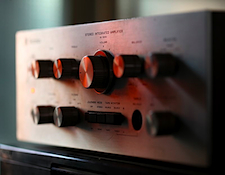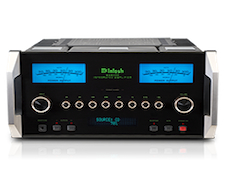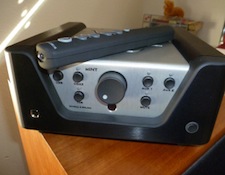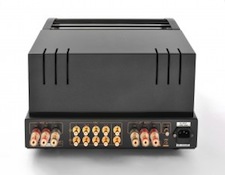It’s the time of year for saving money!
Wanna get the very best cables FREE? Go buy a receiver or an integrated amplifier. It’s true, and, of course, the reason that it’s true ― at least for certain interconnects ― is that neither of those products uses any cables at all.
 Instead of an ordinary component system, that has separate EVERYTHING, and needs interconnects to run from a tuner to a preamp and from the preamp to a power amplifier, integrated components (there are even some “super” receivers that include a CD or DVD player, too) build everything into a single box and, at least for their own internal connections, need no cables at all.
Instead of an ordinary component system, that has separate EVERYTHING, and needs interconnects to run from a tuner to a preamp and from the preamp to a power amplifier, integrated components (there are even some “super” receivers that include a CD or DVD player, too) build everything into a single box and, at least for their own internal connections, need no cables at all.
Think about it; it really CAN be the best of all possible worlds: Consider just connectors, for example. Which type is best? RCA? XLR? CAMAC or FISCHER connectors? (like some of the older Mark Levinson gear used to use) Something else, entirely? Not using cables means that integrated components don’t use connectors, either, so every internal connection is hard-wired (unless special conditions or applications require otherwise) and, many would argue, “perfect”.
What about the wire that’s used to connect the various sections together? For most electronic component, integrated or not, the “wire” isn’t wire at all, but circuit board traces ― nice wide flat “ribbons” that many would contend are, because of their shape, better and lower in inductive losses than the conventionally round wiring used in cables might be. Even for those very rare (and usually very expensive products) that are “point-to-point” wired by hand, considerations of “skin effect” or even just convenience can result in wires being of a smaller effective “gauge” (“AWG” American Wire Gauge is a world standard for wire thickness and therefore of effective metal content) and, because thinner wires (less total metal per length) have more resistance to current flow, generous circuit board traces can offer lower effective resistance, too.
 And how about the actual metal that the “wires” are made of? One of the reasons commonly given for some cable designers’ preference for silver or silver-plated-copper wiring is the FACT (Yes, it really IS true) that silver is (take your pick) more conductive or less resistant to current flow than copper. The actual difference will vary with the purity and crystal structure of both metals, but can be as much as about 11%. That’s impressive, but if you just want less total resistance from EITHER material, all you have to do is to make your cables, internal wiring, or circuit traces shorter. I don’t know of any printed circuit boards that use anything other than copper conductors, but the simple fact that integrated components are all built in a single box means that, whether by PCB traces or by actual wires soldered point-to-point, their wiring will, except for the truly rare exception, ALWAYS be shorter and therefore (given the same gauge of the same metal) of lower resistance than any cable, regardless of the type of metal used for its conductors.
And how about the actual metal that the “wires” are made of? One of the reasons commonly given for some cable designers’ preference for silver or silver-plated-copper wiring is the FACT (Yes, it really IS true) that silver is (take your pick) more conductive or less resistant to current flow than copper. The actual difference will vary with the purity and crystal structure of both metals, but can be as much as about 11%. That’s impressive, but if you just want less total resistance from EITHER material, all you have to do is to make your cables, internal wiring, or circuit traces shorter. I don’t know of any printed circuit boards that use anything other than copper conductors, but the simple fact that integrated components are all built in a single box means that, whether by PCB traces or by actual wires soldered point-to-point, their wiring will, except for the truly rare exception, ALWAYS be shorter and therefore (given the same gauge of the same metal) of lower resistance than any cable, regardless of the type of metal used for its conductors.
The one place where cables and (yes, it, too) point-to-point internal wiring CAN (but not necessarily WILL) have an advantage over PCB traces is in their dielectric. The dielectrics of printed circuit boards, ― the material that the substrate (the board, itself) is made of ― range from epoxy-impregnated paper to various forms of woven and non-woven glass fiber with epoxy, to phenolics, to glass and polyester, to (on special order), polyethylene and polyethylene mixes, and, ultimately, to PTFE Teflon®. What the substrate is made of and what material the circuit traces are sealed with to prevent oxidation or other chemical effects will affect the performance or the PCB, just as the insulating material on a wire or a cable will, and Teflon®, the best plastic insulating material currently available is much more likely to be used on point-to-point wiring or in cables than it is in PCB substrates. Even so, the advantage of shorter run lengths still goes to the integrated component, regardless of how it is wired.
]]> Still another area where integrated components have an advantage by virtue of not requiring cables for their function-to-function hookup is the issue of shielding. XLO Electric, the cable company that I founded and designed for, NEVER used shielding as a standard feature on anything other than its phono cables, but relied, instead, on an exclusive self-shielding winding geometry. The reason for this was that actual shielding, no matter how well done, effectively adds another capacitor to a cable’s design and will always have at least SOME effect on its performance. When XLO’s customers, for whatever reason (perhaps an unusually electromagnetic “noise” environment) insisted on shielding for specific cables, we did offer it, but as an optional extra-cost accessory that combined air and Teflon dielectrics in a separately-grounded “Faraday Cage” configuration to provide maximum protection with the least possible negative effect on performance. Integrated components do that same sort of thing automatically, and at no extra cost at all, with the grounded metal cabinet acting as its own all-inclusive Faraday Cage to provide protection to all of the circuits and connections at the same time.
Still another area where integrated components have an advantage by virtue of not requiring cables for their function-to-function hookup is the issue of shielding. XLO Electric, the cable company that I founded and designed for, NEVER used shielding as a standard feature on anything other than its phono cables, but relied, instead, on an exclusive self-shielding winding geometry. The reason for this was that actual shielding, no matter how well done, effectively adds another capacitor to a cable’s design and will always have at least SOME effect on its performance. When XLO’s customers, for whatever reason (perhaps an unusually electromagnetic “noise” environment) insisted on shielding for specific cables, we did offer it, but as an optional extra-cost accessory that combined air and Teflon dielectrics in a separately-grounded “Faraday Cage” configuration to provide maximum protection with the least possible negative effect on performance. Integrated components do that same sort of thing automatically, and at no extra cost at all, with the grounded metal cabinet acting as its own all-inclusive Faraday Cage to provide protection to all of the circuits and connections at the same time.
Obviously, any input sources to a receiver or integrated amplifier that are not built as part of it will require cables for connection, and, equally obviously, speakers will always (even if “wireless”) require cables of one kind or another to hook them (or their transmitters) up. Even so, especially considering how just plain EXPENSIVE great cables can be, and then adding-in the fact that an integrated component’s non-cable internal connection can actually be better, it becomes readily apparent that, for any number of reasons, the very best cable is no cable at all!
 Even so, as we have seen, even integrated components still require cables for some applications. How those cables ― or indeed, any cables at all ― can be made better and how people have gone about trying to do just that will be the subject of Part 2 of this article.
Even so, as we have seen, even integrated components still require cables for some applications. How those cables ― or indeed, any cables at all ― can be made better and how people have gone about trying to do just that will be the subject of Part 2 of this article.
See you next time!





